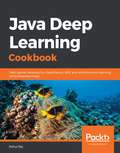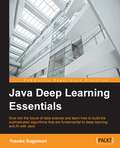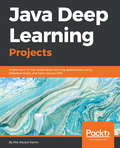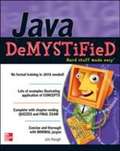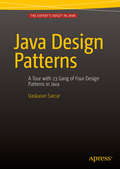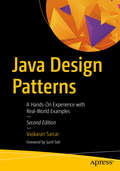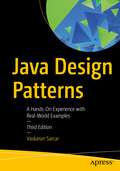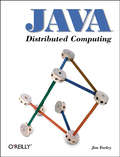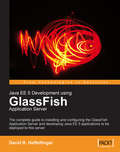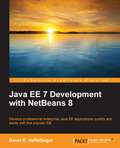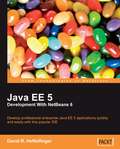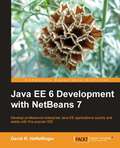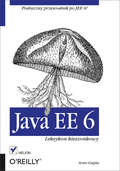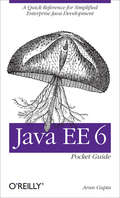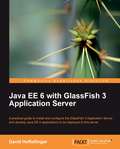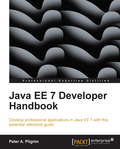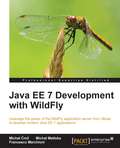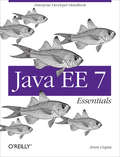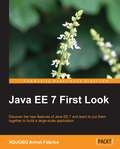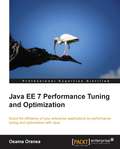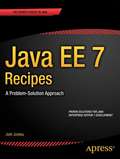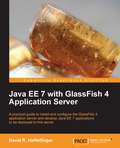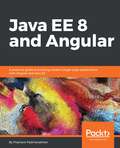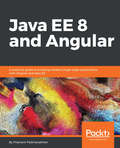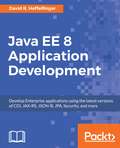- Table View
- List View
Java Deep Learning Cookbook: Train neural networks for classification, NLP, and reinforcement learning using Deeplearning4j
by Rahul RajUse Java and Deeplearning4j to build robust, scalable, and highly accurate AI models from scratch Key Features Install and configure Deeplearning4j to implement deep learning models from scratch Explore recipes for developing, training, and fine-tuning your neural network models in Java Model neural networks using datasets containing images, text, and time-series data Book Description Java is one of the most widely used programming languages in the world. With this book, you will see how to perform deep learning using Deeplearning4j (DL4J) – the most popular Java library for training neural networks efficiently. This book starts by showing you how to install and configure Java and DL4J on your system. You will then gain insights into deep learning basics and use your knowledge to create a deep neural network for binary classification from scratch. As you progress, you will discover how to build a convolutional neural network (CNN) in DL4J, and understand how to construct numeric vectors from text. This deep learning book will also guide you through performing anomaly detection on unsupervised data and help you set up neural networks in distributed systems effectively. In addition to this, you will learn how to import models from Keras and change the configuration in a pre-trained DL4J model. Finally, you will explore benchmarking in DL4J and optimize neural networks for optimal results. By the end of this book, you will have a clear understanding of how you can use DL4J to build robust deep learning applications in Java. What you will learn Perform data normalization and wrangling using DL4J Build deep neural networks using DL4J Implement CNNs to solve image classification problems Train autoencoders to solve anomaly detection problems using DL4J Perform benchmarking and optimization to improve your model's performance Implement reinforcement learning for real-world use cases using RL4J Leverage the capabilities of DL4J in distributed systems Who this book is for If you are a data scientist, machine learning developer, or a deep learning enthusiast who wants to implement deep learning models in Java, this book is for you. Basic understanding of Java programming as well as some experience with machine learning and neural networks is required to get the most out of this book.
Java Deep Learning Essentials
by Yusuke SugomoriDive into the future of data science and learn how to build the sophisticated algorithms that are fundamental to deep learning and AI with Java About This Book * Go beyond the theory and put Deep Learning into practice with Java * Find out how to build a range of Deep Learning algorithms using a range of leading frameworks including DL4J, Theano and Caffe * Whether you're a data scientist or Java developer, dive in and find out how to tackle Deep Learning Who This Book Is For This book is intended for data scientists and Java developers who want to dive into the exciting world of deep learning. It would also be good for machine learning users who intend to leverage deep learning in their projects, working within a big data environment. What You Will Learn * Get a practical deep dive into machine learning and deep learning algorithms * Implement machine learning algorithms related to deep learning * Explore neural networks using some of the most popular Deep Learning frameworks * Dive into Deep Belief Nets and Stacked Denoising Autoencoders algorithms * Discover more deep learning algorithms with Dropout and Convolutional Neural Networks * Gain an insight into the deep learning library DL4J and its practical uses * Get to know device strategies to use deep learning algorithms and libraries in the real world * Explore deep learning further with Theano and Caffe In Detail AI and Deep Learning are transforming the way we understand software, making computers more intelligent than we could even imagine just a decade ago. Deep Learning algorithms are being used across a broad range of industries - as the fundamental driver of AI, being able to tackle Deep Learning is going to a vital and valuable skill not only within the tech world but also for the wider global economy that depends upon knowledge and insight for growth and success. It's something that's moving beyond the realm of data science - if you're a Java developer, this book gives you a great opportunity to expand your skillset. Starting with an introduction to basic machine learning algorithms, to give you a solid foundation, Deep Learning with Java takes you further into this vital world of stunning predictive insights and remarkable machine intelligence. Once you've got to grips with the fundamental mathematical principles, you'll start exploring neural networks and identify how to tackle challenges in large networks using advanced algorithms. You will learn how to use the DL4J library and apply Deep Learning to a range of real-world use cases. Featuring further guidance and insights to help you solve challenging problems in image processing, speech recognition, language modeling, this book will make you rethink what you can do with Java, showing you how to use it for truly cutting-edge predictive insights. As a bonus, you'll also be able to get to grips with Theano and Caffe, two of the most important tools in Deep Learning today. By the end of the book, you'll be ready to tackle Deep Learning with Java. Wherever you've come from - whether you're a data scientist or Java developer - you will become a part of the Deep Learning revolution! Style and approach This is a step-by-step, practical tutorial that discusses key concepts. This book offers a hands-on approach to key algorithms to help you develop a greater understanding of deep learning. It is packed with implementations from scratch, with detailed explanation that make the concepts easy to understand and follow.
Java Deep Learning Projects: Implement 10 real-world deep learning applications using Deeplearning4j and open source APIs
by Md. Rezaul KarimBuild and deploy powerful neural network models using the latest Java deep learning librariesKey Features Understand DL with Java by implementing real-world projects Master implementations of various ANN models and build your own DL systems Develop applications using NLP, image classification, RL, and GPU processingBook DescriptionJava is one of the most widely used programming languages. With the rise of deep learning, it has become a popular choice of tool among data scientists and machine learning experts.Java Deep Learning Projects starts with an overview of deep learning concepts and then delves into advanced projects. You will see how to build several projects using different deep neural network architectures such as multilayer perceptrons, Deep Belief Networks, CNN, LSTM, and Factorization Machines.You will get acquainted with popular deep and machine learning libraries for Java such as Deeplearning4j, Spark ML, and RankSys and you’ll be able to use their features to build and deploy projects on distributed computing environments.You will then explore advanced domains such as transfer learning and deep reinforcement learning using the Java ecosystem, covering various real-world domains such as healthcare, NLP, image classification, and multimedia analytics with an easy-to-follow approach. Expert reviews and tips will follow every project to give you insights and hacks.By the end of this book, you will have stepped up your expertise when it comes to deep learning in Java, taking it beyond theory and be able to build your own advanced deep learning systems.What you will learnMaster deep learning and neural network architecturesBuild real-life applications covering image classification, object detection, online trading, transfer learning, and multimedia analytics using DL4J and open-source APIsTrain ML agents to learn from data using deep reinforcement learningUse factorization machines for advanced movie recommendationsTrain DL models on distributed GPUs for faster deep learning with Spark and DL4JEase your learning experience through 69 FAQsWho this book is forIf you are a data scientist, machine learning professional, or deep learning practitioner keen to expand your knowledge by delving into the practical aspects of deep learning with Java, then this book is what you need! Get ready to build advanced deep learning models to carry out complex numerical computations. Some basic understanding of machine learning concepts and a working knowledge of Java are required.
Java Demystified
by Jim Keogh Wendy RinaldiLearn Java with this fun and painless self-teaching guide. Easy-to-understand, step-by-step instruction explains the most commonly used programming language for designing dynamic Web pages. Numerous examples, quizzes at the end of each chapter, and a final exam solidify the knowledge you have learned.
Java Design Patterns
by Vaskaran SarcarLearn how to implement design patterns in Java: each pattern in Java Design Patterns is a complete implementation and the output is generated using Eclipse, making the code accessible to all. The examples are chosen so you will be able to absorb the core concepts easily and quickly. This book presents the topic of design patterns in Java in such a way that anyone can grasp the idea. By giving easy to follow examples, you will understand the concepts with increasing depth. The examples presented are straightforward and the topic is presented in a concise manner. Key features of the book: Each of the 23 patterns is described with straightforward Java code. There is no need to know advanced concepts of Java to use this book. Each of the concepts is connected with a real world example and a computer world example. The book uses Eclipse IDE to generate the output because it is the most popular IDE in this field. This is a practitioner's book on design patterns in Java. Design patterns are a popular topic in software development. A design pattern is a common, well-described solution to a common software problem. There is a lot of written material available on design patterns, but scattered and not in one single reference source. Also, many of these examples are unnecessarily big and complex. What you'll learn Each of the pattern is described with simple Java examples. There is no need to know advanced concepts of Java to use this book. Each of the concepts is connected with a real world example and a computer world example. The book uses Eclipse IDE to generate the output because it is the most popular IDE in this field. All 23 patterns are explained through unique real world examples. Who this book is for Software developers, software testers and software architects. In general, the book will have significant importance to any programming lovers. Table of Contents Introduction Observer Pattern Singleton Pattern Proxy Pattern Decorator Pattern Strategy Pattern (Or, Policy Pattern) Template Method Pattern Prototype Pattern Adapter Pattern Command Pattern Iterator Pattern Facade Pattern Factory Method Pattern Memento Pattern State Pattern Builder Pattern Flyweight Pattern Abstract Factory Pattern Mediator Pattern Chain of Responsibility Pattern Composite Pattern Bridge Pattern (Or Handle/Body Pattern) Visitor Pattern Interpreter Pattern FAQ Reference Acknowledgements About the Author
Java Design Patterns: A Hands-On Experience with Real-World Examples
by Vaskaran SarcarGet hands-on experience implementing 26 of the most common design patterns using Java and Eclipse. In addition to Gang of Four (GoF) design patterns, you will also learn about alternative design patterns, and understand the criticisms of design patterns with an overview of anti-patterns. For each pattern you will see at least one real-world scenario, a computer-world example, and a complete implementation including output.This book has three parts. The first part covers 23 Gang of Four (GoF) design patterns. The second part includes three alternative design patterns. The third part presents criticisms of design patterns with an overview of anti-patterns. You will work through easy-to-follow examples to understand the concepts in depth and you will have a collection of programs to port over to your own projects.A Q&A session is included in each chapter and covers the pros and cons of each pattern. The last chapter presents FAQs about the design patterns. The step-by-step approach of the book helps you apply your skills to learn other patterns on your own, and to be familiar with the latest version of Java and Eclipse.What You'll Learn Work with each of the design patternsImplement design patterns in real-world applicationsChoose from alternative design patterns by comparing their pros and consUse the Eclipse IDE to write code and generate outputRead the in-depth Q&A session in each chapter with pros and cons for each design patternWho This Book Is For Software developers, architects, and programmers
Java Design Patterns: A Hands-On Experience with Real-World Examples
by Vaskaran SarcarUse the step-by-step approach of this book to learn and implement design patterns in real-world applications. It focuses on classical design patterns with Java 17 and Eclipse (2021-09). In addition to Gang of Four (GoF) design patterns, the book covers popular and alternative design patterns and includes criticisms of design patterns in a chapter on anti-patterns. The book is divided into four parts. Part one covers the SOLID design principles and the Simple Factory pattern. Part two covers the 23 (GoF) design patterns, including the creational patterns, structural patterns, and behavioral patterns. Part three covers alternative design patterns, including the Null Object pattern, and the model-view-controller (MVC) pattern. Part four covers criticisms of design patterns with a quick overview of anti-patterns. It also includes a chapter on FAQs on design patterns.The book also includes a chapter on FAQs on design patterns. Each pattern is explained with real-world examples and the pros and cons of each of the design patterns are discussed. The book concludes with FAQs that can help you prepare for a job interview.What You Will LearnKnow the SOLID design principles in depthImplement the 23 design patterns from the GoFApply the Null Object pattern, Simple Factory pattern, and the MVC patternKnow the criticism of design patterns Understand the anti-patternsVerify your understanding through Q&A sessionsSelect an alternative to these patterns by comparing their pros and consWho This Book Is ForSoftware developers, architects, and programmers
Java Distributed Computing (Java Series)
by Jim FarleyJava Distributed Computing offers a general introduction to distributed computing, meaning programs that run on two or more systems. It focuses primarily on how to structure and write distributed applications and discusses issues like designing protocols, security, working with databases, and dealing with low bandwidth situations.
Java EE 5 Development using GlassFish Application Server
by David HeffelfingerThe book aims to speed up the reader in Java EE 5 development. All major Java EE 5 APIs and the details of the GlassFish server are covered followed by examples of its use. This book is aimed at Java developers wishing to become proficient with Java EE 5, who are expected to have some experience with Java and to have developed and deployed applications in the past, but need no previous knowledge of Java EE or J2EE. It teaches the reader how to use GlassFish to develop and deploy applications.
Java EE 5 Development with NetBeans 6
by David R. HeffelfingerThis book takes you through the important parts of Java EE development and, with clear, careful instructions and screenshots, shows you the relevant features of the NetBeans IDE. The book is aimed at Java developers who wish to develop Java EE applications while taking advantage of NetBeans functionality to automate repetitive tasks and to ease their software development efforts. Familiarity with Java EE is not assumed.
Java EE 5 Development with NetBeans 6
by David R. HeffelfingerThis book takes you through the important parts of Java EE development and, with clear, careful instructions and screenshots, shows you the relevant features of the NetBeans IDE. The book is aimed at Java developers who wish to develop Java EE applications while taking advantage of NetBeans functionality to automate repetitive tasks and to ease their software development efforts. Familiarity with Java EE is not assumed.
Java EE 6 Development with NetBeans 7
by David R. HeffelfingerThe book is a practical guide explaining the various features of the NetBeans IDE related to enterprise application development. The book is aimed at Java developers who wish to develop Java EE applications while taking advantage of NetBeans functionality to automate repetitive tasks and to ease their software development efforts. Familiarity with NetBeans or Java EE is not assumed.
Java EE 6. Leksykon kieszonkowy
by Arun GuptaKorporacyjna wersja Javy (JEE, od ang. Java Enterprise Edition) ?wi?ci triumfy. Naj?wie?sza ods?ona tego j?zyka, oznaczona numerem 6, rozwi?zuje problemy znane z poprzednich wersji oraz wprowadza wiele nowo?ci i ulepsze?. Dzi?ki tym zmianom praca programistów sta?a si? tak przyjemna i wydajna, jak nigdy przedtem. Przejrzyste API, wstrzykiwanie zale?no?ci (CDI) oraz dobre wsparcie dla us?ug sieciowych i formatu REST (JAX-RS) to tylko niektóre z atutów JEE6.Ten wyj?tkowo por?czny leksykon dostarczy Ci gar?? najwa?niejszych informacji o JEE6, które zawsze mo?esz mie? pod r?k?. W trakcie lektury dowiesz si?, jak nowe elementy platformy wp?ywaj? na znane wzorce projektowe i jak korzysta? z Java Persistence API (JPA). Poznasz tak?e charakterystyk? ka?dego rodzaju ziarna Enterprise JavaBeans (EJB). Ponadto nauczysz si? tworzy? us?ugi sieciowe w oparciu o protokó? SOAP i REST oraz korzysta? z us?ug rozsy?aj?cych wiadomo?ci (JMS). Na sam koniec zobaczysz, jak zapewni? integralno?? Twoim danym z wykorzystaniem BeanValidation (JSR-303). Obowi?zkowa pozycja dla ka?dego programisty JEE6.Jeszcze nigdy tak szeroki zbiór informacji nie by? dost?pny w równie por?cznej formie. Musisz go mie?!Sprawd?:co nowego kryje platforma JEE6jak wstrzykiwa? zale?no?cido czego s?u?? profilejak dostosowa? aplikacj? do platformy JEE6 Wykorzystaj potencja? korporacyjnej wersji j?zyka Java!
Java EE 6 Pocket Guide
by Arun Gupta<p>This handy guide provides an overview of Java Enterprise Edition 6’s main technologies and includes extensive, easy-to-understand code samples that demonstrate the platform’s many improvements. You’ll quickly understand how Java EE 6 simplifies the process of developing and deploying web and enterprise applications.</p>
Java EE 6 with GlassFish 3 Application Server
by David R. HeffelfingerThis book is a practical guide with a very user-friendly approach. It aims to speed up the reader in Java EE 6 development. All major Java EE 6 APIs and the details of the GlassFish 3 server are covered followed by examples of its use. If you are a Java developer and wish to become proficient with Java EE 6, then this book is for you. You are expected to have some experience with Java and to have developed and deployed applications in the past, but need no previous knowledge of Java EE or J2EE. You will also learn how to use GlassFish 3 to develop and deploy applications.
Java EE 7 Developer Handbook
by Peter A. PilgrimJava EE 7 Handbook is an example based tutorial with descriptions and explanations."Java EE 7 Handbook" is for the developer, designer, and architect aiming to get acquainted with the Java EE platform in its newest edition. This guide will enhance your knowledge about the Java EE 7 platform. Whether you are a long-term Java EE (J2EE) developer or an intermediate level engineer on the JVM with just Java SE behind you, this handbook is for you, the new contemporary Java EE 7 developer!
Java EE 7 Development with WildFly
by Michal Cmil Michal MatlokaIf you are a Java developer who wants to learn about Java EE, this is the book for you. It's also ideal for developers who already have experience with the Java EE platform but would like to learn more about the new Java EE 7 features by analyzing fully functional sample applications using the new application server WildFly.
Java EE 7 Essentials: Enterprise Developer Handbook
by Arun GuptaGet up to speed on the principal technologies in the Java Platform, Enterprise Edition 7, and learn how the latest version embraces HTML5, focuses on higher productivity, and provides functionality to meet enterprise demands. Written by Arun Gupta, a key member of the Java EE team, this book provides a chapter-by-chapter survey of several Java EE 7 specifications, including WebSockets, Batch Processing, RESTful Web Services, and Java Message Service. You'll also get self-paced instructions for building an end-to-end application with many of the technologies described in the book, which will help you understand the design patterns vital to Java EE development. Understand the key components of the Java EE platform, with easy-to-understand explanations and extensive code samples Examine all the new components that have been added to Java EE 7 platform, such as WebSockets, JSON, Batch, and Concurrency Learn about RESTful Web Services, SOAP XML-based messaging protocol, and Java Message Service Explore Enterprise JavaBeans, Contexts and Dependency Injection, and the Java Persistence API Discover how different components were updated from Java EE 6 to Java EE 7
Java EE 7 First Look
by Ndjobo Armel FabriceAn easy-to-follow guide to reveal the new features of Java EE 7 and how to efficiently utilize them.Given the main objectives pursued, this book targets three groups of people with a knowledge of the Java language. They are:Beginners in the Java EE platform who would like to have an idea about the main specifications of Java EE 7.Developers who have experimented with previous versions of Java EE and who would like to explore the new features of Java EE 7.Building architects who want to learn how to put together the various Java EE 7 specifications for building robust and secure enterprise applications.
Java EE 7 Performance Tuning and Optimization
by Osama OransaThe book adopts a step-by-step approach, starting from building the basics and adding to it gradually by using different tools and examples. The book sequence is easy to follow and all topics are fully illustrated showing you how to make good use of different performance diagnostic tools. If you are an experienced Java developer, architect, team leader, consultant, support engineer, or anyone else who needs performance tuning in your Java applications, and in particular, Java enterprise applications, this book is for you. No prior experience of performance tuning is required.
Java EE 7 Recipes: A Problem-Solution Approach
by Josh JuneauJava EE 7 Recipes takes an example-based approach in showing how to program Enterprise Java applications in many different scenarios. Be it a small-business web application, or an enterprise database application, Java EE 7 Recipes provides effective and proven solutions to accomplish just about any task that you may encounter. You can feel confident using the reliable solutions that are demonstrated in this book in your personal or corporate environment. The solutions in Java EE 7 Recipes are built using the most current Java Enterprise specifications, including EJB 3.2, JSF 2.2, Expression Language 3.0, Servlet 3.1, and JMS 2.0. While older technologies and frameworks exist, it is important to be forward-looking and take advantage of all that the latest technologies offer. Rejuvenate your Java expertise to use the freshest capabilities, or perhaps learn Java Enterprise development for the first time and discover one of the most widely used and most powerful platforms available for application development today. Let Java EE 7 Recipes show you the way by showing how to build streamlined and reliable applications much faster and easier than ever before by making effective use of the latest frameworks and features on offer in the Java EE 7 release. Shows off the most current Java Enterprise Edition technologies. Provides solutions to creating sophisticated user interfaces. Demonstrates proven solutions for effective database access.
Java EE 7 with GlassFish 4 Application Server
by David R. HeffelfingerThis book is a practical guide and follows a very user-friendly approach. The book aims to get the reader up to speed in Java EE 7 development. All major Java EE 7 APIs and the details of the GlassFish 4 server are covered followed by examples of their use. If you are a Java developers who wants to become proficient with Java EE 7 this book is ideal for you. Readers are expected to have some experience with Java and to have developed and deployed applications in the past, but don’t need any previous knowledge of Java EE or J2EE. It teaches the reader how to use GlassFish 4 to develop and deploy applications.
Java EE 8 and Angular: Build Modern User Friendly Web Apps With Java Ee
by Prashant PadmanabhanThe demand for modern and high performing web enterprise applications is growing rapidly. No more is a basic HTML front-end enough to meet customer demands. This book will be your one stop guide to build outstanding enterprise web applications with Java EE and Angular. It will teach you how to harness the power of Java EE to build sturdy back ends while applying Angular on the front end. Your journey to building excellent web enterprise applications starts here!
Java EE 8 and Angular: Build modern user friendly web apps with Java EE
by Sukma Wardana Prashant PadmanabhanLearn how to build high-performing enterprise applications using Java EE powered by Angular at the frontend Key Features Leverage Java EE 8 features to build robust backend for your enterprise applications Use Angular to build a single page frontend and combine it with the Java EE backend A practical guide filled with ample real-world examples Book Description The need for high-performing web enterprise applications is growing rapidly. No longer is a basic HTML frontend enough to meet customer demands. This book will be your one-stop guide to build outstanding enterprise web applications with Java EE and Angular. It will teach you to harness the power of Java EE to build sturdy backends while applying Angular on the frontend. Your journey to building excellent web enterprise applications starts here! The book starts with a brief introduction to the fundamentals of Java EE and all the new APIs offered in the latest release. Armed with the knowledge of Java EE 8, you will cover what it’s like to build an end-to-end application, configure database connection for JPA, and build a scalable microservice using RESTful APIs running in Docker containers. Taking advantage of Payaramicro capabilities, you will build an Issue Management System, which will have various features as services using Java EE backend. With a detailed coverage of Angular fundamentals, the book will expand the Issue Management System by building a modern single page application frontend. Moving forward, you will learn to fit both the pieces together; both the frontend Angular application and the backend Java EE microservices. As each unit in a microservice promotes high cohesion, you will learn different ways in which independent units can be tested efficiently. The book ends on a high note—concepts on securing your enterprise applications. This is your ultimate guide to building Modern Web Applications. What you will learn Write CDI-based code in Java EE 8 applications Build an understanding of microservices and what they mean in a Java EE context Employ Docker to build and run microservice applications Use configuration optionsto work effectively with JSON documents Handle asynchronous task and write RESTAPI clients Set the foundation for working on Angular projects with the fundamentals of TypeScript Learn to use Angular CLI to add and manage new features Secure Angular applicationsusing malicious attacks adopting JSON Web tokensWho this book is for This book is for Java EE developers who would like to build modern enterprise web applications using Angular. No knowledge of Angular is required.
Java EE 8 Application Development
by David R. HeffelfingerDevelop Enterprise Java applications compliant with the latest version of the Java EE specification About This Book • This book covers all of the major Java EE 8 APIs and includes new additions such as enhanced Security, JSON-B Processing, and more • Learn additional Java EE APIs, such as the Java API for Websocket and the Java Message Service (JMS) • Develop applications by taking advantage of the latest versions of CDI, Security, Servlets, and JSF and other Java EE specifications Who This Book Is For If you are a Java developer who wants to become proficient with Java EE 8, this book is ideal for you. You are expected to have some experience with Java and to have developed and deployed applications in the past, but you don't need any previous knowledge of Java EE. What You Will Learn • Develop and deploy Java EE applications • Embrace the latest additions to the Contexts and Dependency Injection (CDI) specification to develop Java EE applications • Develop web-based applications by utilizing the latest version of JavaServer Faces, JSF 2.3. • Understand the steps needed to process JSON data with JSON-P and the new JSON-B Java EE API • Implement RESTful web services using the new JAX-RS 2.1 API, which also includes support for Server-Sent Events (SSE) and the new reactive client API In Detail Java EE is an Enterprise Java standard. Applications written to comply with the Java EE specification do not tie developers to a specific vendor; instead they can be deployed to any Java EE compliant application server. With this book, you'll get all the tools and techniques you need to build robust and scalable applications in Java EE 8. This book covers all the major Java EE 8 APIs including JSF 2.3, Enterprise JavaBeans (EJB) 3.2, Contexts and Dependency Injection (CDI) 2.0, the Java API for WebSockets, JAX-RS 2.1, Servlet 4.0, and more. The book begins by introducing you to Java EE 8 application development and goes on to cover all the major Java EE 8 APIs. It goes beyond the basics to develop Java EE applications that can be deployed to any Java EE 8 compliant application server. It also introduces advanced topics such as JSON-P and JSON-B, the Java APIs for JSON processing, and the Java API for JSON binding. These topics dive deep, explaining how the two APIs (the Model API and the Streaming API) are used to process JSON data. Moving on, we cover additional Java EE APIs, such as the Java API for Websocket and the Java Message Service (JMS), which allows loosely coupled, asynchronous communication. Further on, you'll discover ways to secure Java EE applications by taking advantage of the new Java EE Security API. Finally, you'll learn more about the RESTful web service development using the latest JAX-RS 2.1 specification. You'll also get to know techniques to develop cloud-ready microservices in Java EE. Style and approach The book takes a pragmatic approach, showing you various techniques to utilize new features of Java EE 8 specification. It is packed with clear, step-by-step instructions, practical examples, and straightforward explanations.
